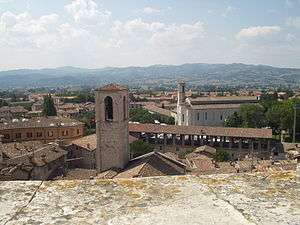Gubbio
Gubbio is a lovely small walled medieval city in Umbria in central Italy. It is located to the northeast of Perugia on the slopes of Monte Ingino. The city's history dates back to the Pre-Roman era.
Get in
By train
In a country well-served by railways Gubbio is unusual in that the closest station, on the Rome-Ancona line, is 18 km away at Fossato di Vico station. There is a bus service from there. An alternative is to take the train to Perugia and take a bus from there (40 km).
By road
If coming from the north coast (e.g. if you were driving down the coast from Venice) leave the A14 Autostrada at Fano.
From the north on the A1 Autostrada, exit at Arezzo. From Rome and the south exit the A1 at Orte and follow signs to Perugia and then to Gubbio.
Get around
Within the walls, traffic is restricted, so be prepared to walk, if you are physically able.
- The Funivia. This is a very basic cable car in which you stand in a two-person cage. It takes you from the center, near Porta Romana, up to the Basilica of St. Ubaldo.
See
.jpg)
- 🌍 Palazzo dei Consoli. Built in 1332‑1337, this is an impressive public building. It required tremendous engineering work to create a large enough flat space on the side of a hill in order to construct the Palace, which together with the Piazza della Signoria in front of it, was erected on a massive arched structure.
- 🌍 Basilica of St. Ubaldo (Take the funivia). St. Ubaldo is the patron saint of Gubbio and his ashes are preserved in an urn on an altar in the church. The cloister is particularly attractive.
- 🌍 Palazzo Ducale. An ancient palace that was restructured in the 15th Century in Renaissance style. Many of the original furnishings ended up in the Metropolitan Museum of New York.
- 🌍 Cathedral. This is a Gothic 14th-century church. The façade, which was restored in the 16th century, has a beautiful Gothic portal and is richly decorated. Inside there are ten arches that support the roof. Contains some interesting paintings.

- 🌍 Piazza 40 Martiri. The piazza commemorates 40 people of Gubbio shot by German forces in June 1944. A mausoleum has been erected in their honour. In the piazza is the church of St. Francis (S. Francesco), after St. Francis of Assisi who lived in Gubbio for a time.
- Fountain of the Mad. Supposedly, if you run round it three times you will also become mad!
- 🌍 Roman Theatre. This well-preserved building hosts various cultural events in the summer months.
- Museo Civico, in the Palazzo dei Consoli. 10.30-13.00 and 15.00-18.00. An archaeological museum and art gallery. Notable for the Iguvine Tablets, which were seven bronze tablets discovered in Gubbio in 1444. They are also known as the Eugubian tablets. The earliest ones were probably written in the 3rd century BC. The tablets are written in the Umbrian language and shed much light on the grammar of this ancient dead language.
- Mount Ingino Christmas Tree. According to the Guinness Book of World Records, it is ranked at being the world's largest Christmas tree lit up on the slopes of Monte Ingino with over 3,000 multi-coloured lights.
Do
- The Festa dei ceri is a fantastic representation organized every year on 15 May. It consists of a crazy race of three big wooden candles, each weighing around 300 kg, in the narrow streets of the city.
Buy
Eat
Drink
Sleep
- 🌍 Hotel Tre Ceri di Gubbio, Via Benamati 6, ☎ +39 075 92 22 109. Entirely restored in 2001 the hotel Tre Ceri is composed of two buildings from around the 14th century near via dei Consoli.
Splurge
- 🌍 Castello di Petroia Hotel, ☎ +39 075 920287. Localita' Petroia - 06020 Scritto di Gubbio. Situated on a strategic location between Gubbio and Perugia overlooking the Chiascio valley. Petroia Castle has been the scene of many important events of the 12th to 14th centuries. €110-250 for a double.